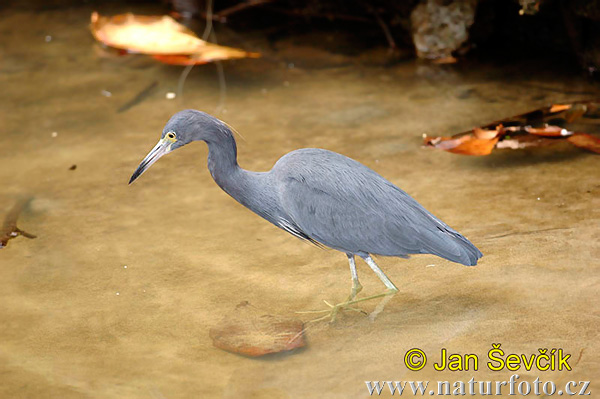 |
| A juvenile Little Blue Heron, Puerto Morelos, Mexico; 12/24/10. |
Another great find and another addition to my Life List was seeing my first Little Blue Heron. Initially when I saw it emerge from the jungly brush across the waterway where we were watching other herons, I thought it was an egret (Snowy or Great) but it didn't look quite like an egret. Its bill wasn't bright yellow as a Great Egret's, and it didn't seem to be as large and fluffy as a Snowy Egret which also has yellow lores around the eyes . When I pointed it out to Luis and asked if it was an egret, it took him only a couple of seconds of looking through his binoculars to conclude, "juvenile Little Blue Heron." It was then I remembered that Little Blues are white before they mature.
 |
| A juvenile Little Blue Heron hunting for a meal in the marsh near Puerto Morelos, Mexico; 12/24/10. |
Mature Little Blue Herons turn a beautiful cobalt blue (Below) throughout and sport a light blue bill with a black tip. Its legs are a pale dull green. Little Blues are found throughout much of the Southeastern states of the US during the summer, but will be a year round resident along the Gulf Coast and the southern Atlantic states as well as the Baja Peninisula. During the winter months it will migrate south into Mexico and Central America. It also lives year round in fresh water estuaries and marshes in the northern half of South America.
 |
| Image of a mature Little Blue Heron; Google Images; photo credit: Jan Sevcik |
Orthinologists are studying as to why Little Blues stay white during its first year. One theory is, because they are loners which do not congregate with its own species, the young white herons are more readily able to mix in well with the white Egrets which otherwise do not tolerate the company of Little Blue Herons in their blue plumage. Young Little Blue "white" herons catch more fish when they are in the company of Egrets than when they are alone. Another advantage of integrating into flocks of Egrets is gaining a measure of protection against predators.
 |
| Another Croc hanging around the banks of the waterways; Puerto Morelos, Mexico; 12/24/10. |
In the hour or so we spent stalking water birds in the marshes near Puerto Morelos, we ran into three (that we know of) separate crocodiles on the banks. The largest (Above) of the three wasn't startled and didn't move (as did the other two) as we came into its personal space. It just opened its mouth to show its teeth as if to say, "You best move along and get outta my territory." We did.






No comments:
Post a Comment